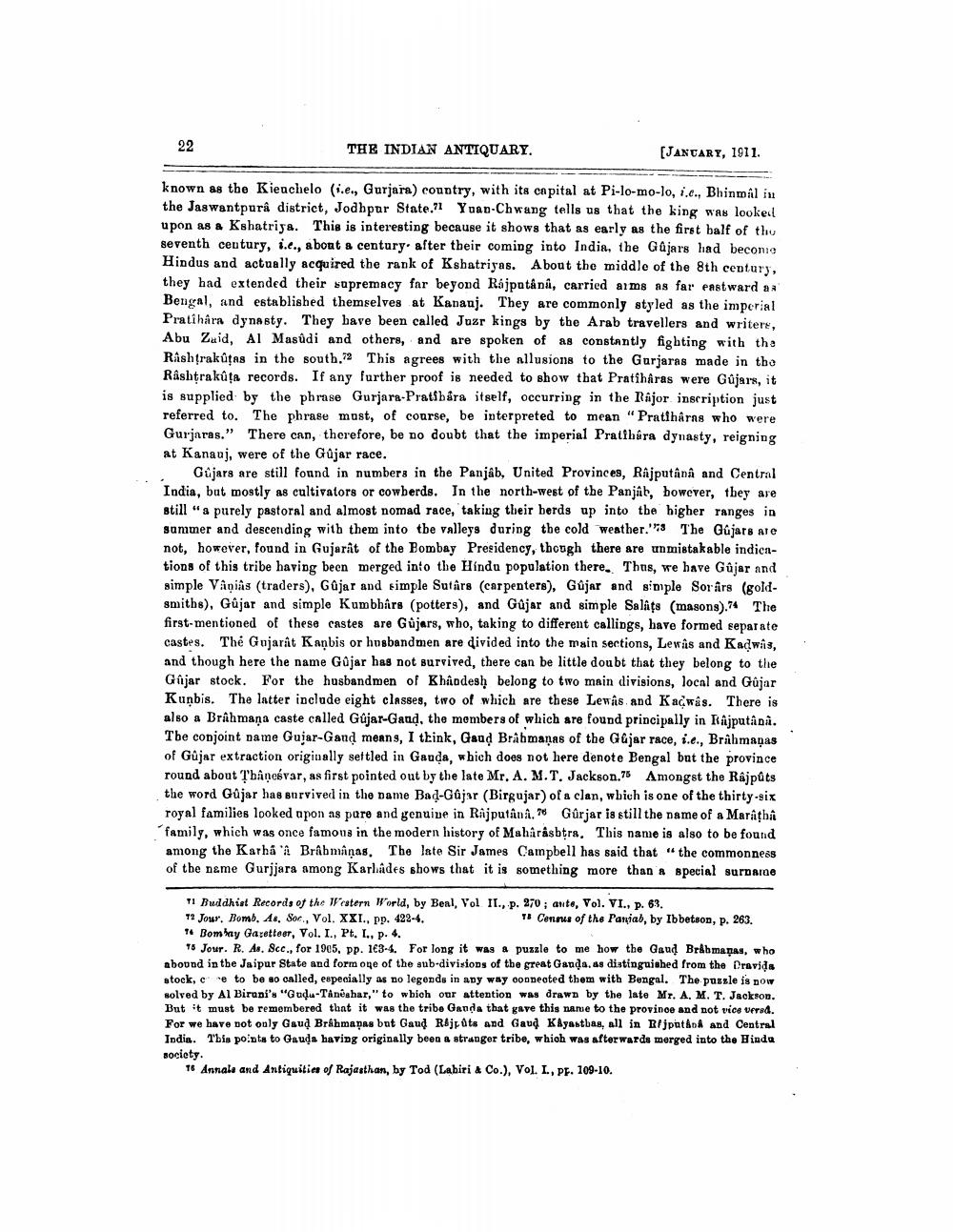________________
22
THE INDIAN ANTIQUARY.
(JANUARY, 1911.
known as the Kieuchelo (ie., Gurjara) country, with its capital at Pi-lo-mo-lo, 1.c., Bhinmal in the Jaswantpurâ district, Jodhpur State.? Yuan-Chwang tells us that the king was looked upon as a Kshatriya. This is interesting because it shows that as early as the first balf of thu seventh century, i.e., about a century. after their coming into India, the Gujars had become Hindus and actually acquired the rank of Kshatriyas. About the middle of the 8th century, they had extended their supremacy far beyond Rájpatána, carried arms as far eastward ax Bengal, and established themselves at Kananj. They are commonly styled as the imperial Pratîhâra dynasty. They have been called Juzr kings by the Arab travellers and writere, Abu Zaid, Al Masudi and others, and are spoken of as constantly fighting with the Rashțrakūtas in the south.72 This agrees with the allusions to the Gurjaras made in tho Rashtrakûța records. If any further proof is needed to show that Pratihâras were Güjars, it is supplied by the phrase Gurjara-Pratibára itself, occurring in the Rajor inscription just referred to. The phrase must, of course, be interpreted to mean "Pratiháras who were Gurjaras." There can, therefore, be no doubt that the imperial Pratthara dynasty, reigning at Kanauj, were of the Gujar race.
Gujars are still found in numbers in the Panjab, United Provinces, Rajputânâ and Central India, but mostly as cultivators or cowberds. In the north-west of the Panjab, bowever, they are still "a purely pastoral and almost nomad race, taking their berds up into the higher ranges in summer and descending with them into the valleys during the cold weather.' The Gujars are not, however, found in Gujarat of the Bombay Presidency, though there are unmistakable indientions of this tribe having been merged into the Hindu population there. Thus, we have Güjar and simple Vânâs (traders), Gajar and simple Sutars (carpenters), Gujar and simple Sorars (goldsmiths), Gujar and simple Kumbhars (potters), and Gujar and simple Salate (masons).74 The first-mentioned of these castes are Gújars, who, taking to different callings, have formed separate castes. The Gujarat Kanbis or husbandmen are divided into the main sections, Lewis and Kadwas, and though here the name Gojar has not survived, there can be little doubt that they belong to the Gajar stock. For the husbandmen of Khandesh belong to two main divisions, local and Gujar Kuņbis. The latter include eight classes, two of which are these Lewas and Kawas. There is also a Brâhmaņa caste called Gujar-Gand, the members of which are found principally in Kajputana. Tbe conjoint name Gujar-Gand means, I think, Gaud Brahmaņas of the Gajar race, i.e., Brahmaņas of Gujar extraction originally settled in Gauda, which does not here denote Bengal but the province round about Thânesrar, as first pointed out by the late Mr. A.M.T. Jackson. Amongst the Rajputs the word Gujar has survived in the name Bad-Gujar (Birgujar) of a clan, which is one of the thirty-six royal families looked upon as pare and genuine in Rajputânâ. Gurjar is still the name of a Maratha family, which was once famous in the modern history of Maharastra. This name is also to be found among the Karha A Brabmaņas. The late Sir James Campbell has said that the commonness of the name Gurjjara among Karlades shows that it is something more than a special surname
T1 Buddhist Records of the Western World, by Beal, Vol II., p. 270 ; ante, Vol. VI. p. 63. 12 Jour, Bomb. A. Soc., Vol. XXI., pp. 422-4.
T3 Cennu of the Pariab, by Ibbetson, p. 263, 16 Bombay Gazetteer, Vol. I., Pt. I, p. 4.
15 Jour. R. A. Sce, for 1905, pp. 1€3-4. For long it was a puzzle to me how the Gaud BrahMADAS, who abound in the Jaipur State and form oge of the sub-divisions of the great Ganda, as distinguished from the Dravida stock, c e to be so called, especially as no legends in any way connected them with Bengal. The pussle is now solved by Al Biruni's "Gudu-Taneshar," to which our attention was drawn by the late Mr. A. M. T. Jackson. But it must be remembered that it was the tribe Ganda that gave this name to the province and not vice vered. For we have not only Gaud Brahmapas but Gaud Rbjputs and Gaud Kayastbas, all in Rijput A and Central India. This points to Gauds having originally been a stranger tribe, which was afterwards merged into the Hindu society.
76 Annala and Antiquities of Rajasthan, by Tod (Labiri & Co.), Vol. L, PF. 109-10.




